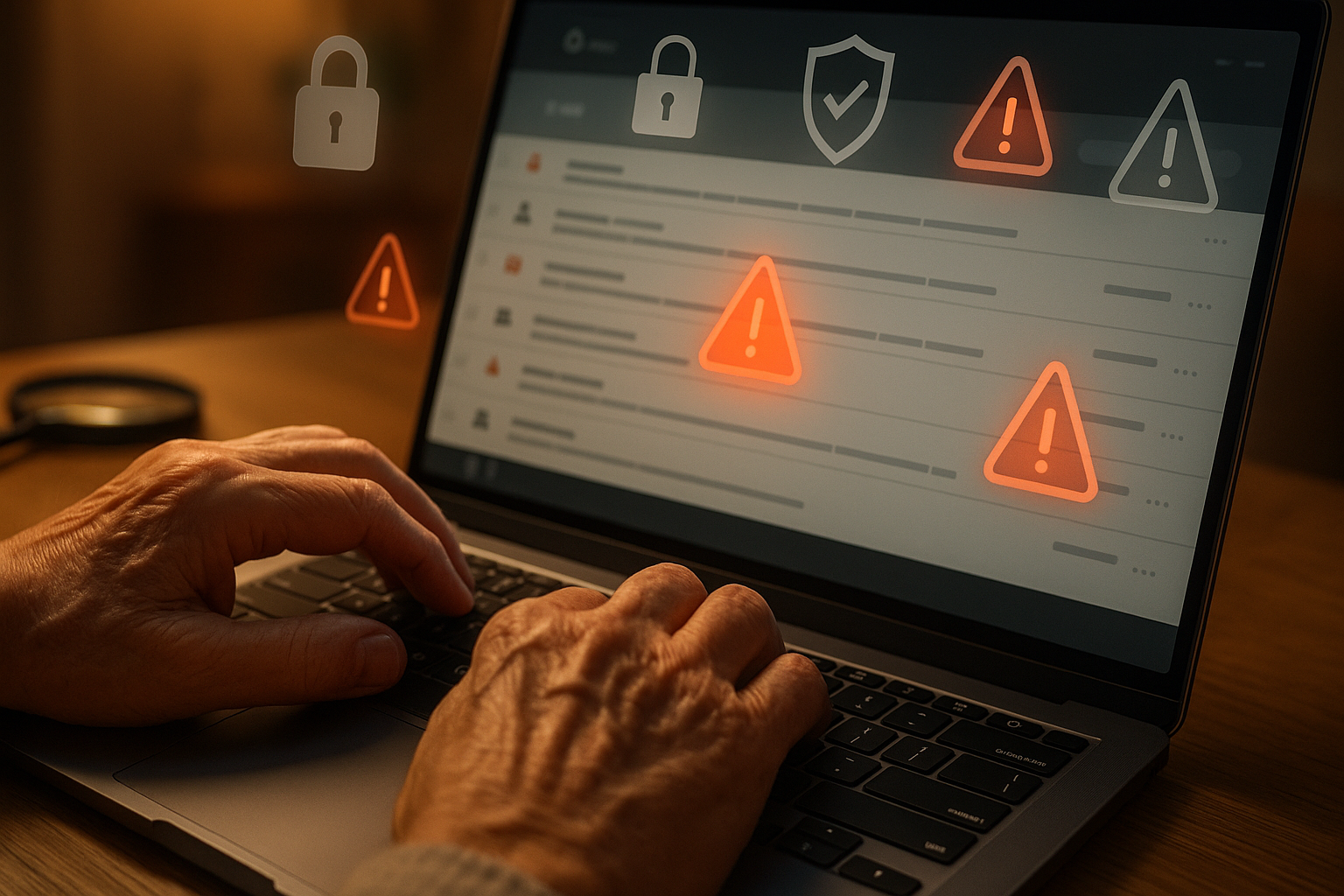.png)
Email Red Flags: 7 Warning Signs That Could Save Your Money and Identity

Every day, millions of seniors receive emails designed to steal their money, personal information, or both. While email has become an essential tool for staying connected with family and managing daily tasks, it's also become the primary weapon of choice for scammers targeting older adults. The good news? Most dangerous emails share common warning signs that, once you know them, make them easy to spot and avoid.
Understanding these email red flags isn't just about protecting your inbox—it's about safeguarding your financial security, personal identity, and peace of mind. In this guide, we'll reveal the seven most critical warning signs that every senior should recognize, along with simple steps you can take immediately to protect yourself from email-based threats.
Want cybersecurity tips delivered directly to your inbox? Join thousands of seniors receiving our weekly Cyber Smart Newsletter with the latest scam alerts and safety tips. Sign Up Now - It's Free!
In This Article, You'll Discover:
- The #1 email red flag that appears in 90% of scam messages
- How to verify suspicious banking and government emails in under 30 seconds
- Warning signs that scammers hope you'll miss (but won't after reading this)
- Real examples of dangerous emails targeting seniors today
- A preview of our comprehensive Email Security Protection Guide (exclusive to subscribers)
Why Seniors Are Prime Email Targets
Before diving into the warning signs, it's important to understand why cybercriminals specifically target seniors through email. Scammers know that many older adults:
- May be less familiar with common online threats
- Often have substantial savings and retirement accounts
- Tend to be more trusting of official-looking communications
- May feel pressure to respond quickly to urgent-sounding messages
This targeting isn't random—it's calculated and deliberate. But when you know what to look for, you can turn the tables and protect yourself effectively.
Red Flag #1: Urgent Language and Artificial Deadlines
The Warning: Emails that demand immediate action using phrases like "Act now!" "Your account will be closed!" or "Respond within 24 hours!"
Why It Works: Scammers create artificial urgency to prevent you from thinking clearly or consulting with family members.
What Legitimate Companies Do: Real banks, government agencies, and businesses typically give you reasonable time to respond and offer multiple ways to contact them.
Your Action: Take a deep breath. Legitimate urgent matters usually involve multiple forms of contact—not just email.
Red Flag #2: Generic Greetings and Poor Grammar
The Warning: Emails that start with "Dear Customer," "Dear Sir/Madam," or contain obvious spelling and grammar mistakes.
Why It's Suspicious: Your bank knows your name. Government agencies have your information. Professional organizations proofread their communications.
Real Example: An email from "Amazon" about a suspicious purchase that addresses you as "Valued Customer" instead of using your actual name.
Your Action: Legitimate companies personalize their communications and maintain professional standards.
Red Flag #3: Suspicious Sender Addresses
The Warning: Email addresses that don't match the organization they claim to represent.
Examples to Watch For:
- An "IRS" email from gmail.com or yahoo.com
- A "bank" email with extra characters (like wellsfargo-security.com instead of wellsfargo.com)
- Government emails from free email services
Your Action: Always check the sender's email address carefully. Hover over it (don't click) to see the full address.
Red Flag #4: Unexpected Attachments or Links
The Warning: Any email asking you to download attachments or click links, especially if you weren't expecting them.
Common Disguises:
- "Invoice" attachments you didn't request
- "Security update" links that don't go to official websites
- "Photo" attachments from unknown senders
Your Action: Never click attachments or links from unexpected emails. When in doubt, contact the organization directly using a phone number you trust.
For detailed guidance on safely verifying banking emails specifically, check out our free guide: Is That Email Really From Your Bank?
Red Flag #5: Requests for Personal Information
The Warning: Any email asking for passwords, Social Security numbers, account numbers, or other sensitive information.
Important Truth: Legitimate organizations never ask for sensitive information via email. Ever.
Common Scam Phrases:
- "Verify your account information"
- "Update your payment details"
- "Confirm your identity"
Your Action: Treat any request for personal information as suspicious. Contact the organization directly using official contact information.
Ready to master email security with step-by-step guidance? Our comprehensive Email Protection Guide includes downloadable checklists, real email examples, and foolproof verification techniques. Get Full Access to Our Learning Hub!
Red Flag #6: Too-Good-to-Be-True Offers
The Warning: Emails promising unrealistic returns, free money, or exclusive deals that seem impossible.
Examples:
- Lottery winnings you didn't enter
- Inheritance from unknown relatives
- Investment opportunities with guaranteed high returns
- "Free" products that require shipping fees
Your Action: Remember the old saying: "If it sounds too good to be true, it probably is."
Red Flag #7: Emotional Manipulation
The Warning: Emails designed to trigger strong emotional responses—fear, sympathy, excitement, or panic.
Common Emotional Triggers:
- Family emergency scams ("Your grandson is in jail!")
- Charity scams following disasters
- Health scares ("Your Medicare benefits are at risk!")
- Romance scams with heartbreaking stories
Your Action: When an email triggers strong emotions, step back and verify independently before responding.
The 30-Second Email Safety Check
Before responding to any unexpected email, ask yourself:
- Do I know this sender personally?
- Was I expecting this email?
- Does the sender's address match the organization?
- Are they asking for money or personal information?
- Does this create artificial urgency?
If you answer "no" to questions 1-2 or "yes" to questions 4-5, delete the email.
When in Doubt, Verify Independently
The most powerful protection against email scams is independent verification. If you receive an unexpected email claiming to be from:
- Your bank: Call the customer service number on your bank card
- The government: Visit the official .gov website directly
- A family member: Call them using a number you already have
- A business: Look up their official contact information online
FAQ: Common Email Security Questions
Q: Can opening an email infect my computer? A: Simply opening most emails is generally safe, but avoid clicking links or downloading attachments from suspicious messages.
Q: What should I do if I already clicked a suspicious link? A: Immediately change passwords for important accounts, run antivirus software, and monitor your accounts for unusual activity.
Q: How can I tell if an email address is legitimate? A: Check that it exactly matches the organization's official domain. Be wary of extra characters, misspellings, or free email services for business communications.
Q: Should I reply to tell scammers to stop emailing me? A: Never reply to suspicious emails. This confirms your email address is active and may result in more scam attempts.
Your Next Steps to Email Safety
You now have the knowledge to spot the most common email red flags that target seniors. These warning signs will help you avoid the majority of email-based scams and protect your personal information from cybercriminals.
But email security goes deeper than recognizing red flags. Complete protection involves understanding advanced phishing techniques, knowing how to secure your email account properly, and having step-by-step response plans for when suspicious emails slip through.
"I finally feel confident about my email safety after years of worry about getting scammed online!" — Margaret K., CSS Member
This article covered the essential basics, but comprehensive email protection requires more than spotting red flags. Cyber Smart Seniors members get exclusive access to our complete Email Security Protection Guide, which includes:
✓ Advanced phishing detection techniques with real-world examples
✓ Step-by-step email security setup for all major email providers
✓ Downloadable verification checklists you can print and keep handy
✓ Deep-dive podcast episodes covering email threats in detail
✓ Weekly updates on the latest email scams targeting seniors
✓ 52 new protective guides each year covering every aspect of online safety
Don't leave your digital security to chance. Join thousands of seniors who've gained peace of mind with expert-guided protection strategies.
Become a Cyber Smart Senior Today!
- - - -
Copyright © 2025 Cyber Smart Seniors. All rights reserved. No part of this publication may be reproduced, distributed, or transmitted in any form or by any means, including photocopying, recording, or other electronic or mechanical methods, without the prior written permission of the publisher, except in the case of brief quotations embodied in critical reviews and certain other noncommercial uses permitted by copyright law.
- - - -









.png)

